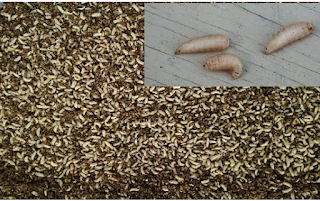Solid Waste is a growing problem all over the world. Openly dumped Municipal Solid Waste is imposing serious health risks and environmental problems, threatening the only Planet we have got till now.
 Out
of all the municipal waste generated in Pakistan, 40-60% is organic and its
management is still a riddle to be solved.
Out
of all the municipal waste generated in Pakistan, 40-60% is organic and its
management is still a riddle to be solved. Unlike inorganic waste, this type of waste gets decomposed, emits methane gas and produces smelly water (leachate) polluting the underground source of water as well. Thus, where everyone wants to live in a healthy and aesthetical environment, uncontrolled dumping of the generated waste cannot be a solution. It is pertinent to mention here that the Organic Municipal Solid Waste stream seeks special attention and calls for an economically feasible bio-waste treatment technique which not only minimizes it but also yields quality compost.
What is Black Soldier Fly (BSF)!
 |
| Black Soldier Fly |
Black Soldier Fly is a native of the Neotropical
Realm (mostly South American land), it goes by the scientific name of Hermetia
Illucens, and has spread worldwide naturally or artificially. When we say
artificially we mean that entrepreneurs, municipal authorities and residents
have started farming them on their own respective possible scale to come up
with an innovative solution to cater the problem of organic waste fraction.
Furthermore
it has been clinically administered that it reduces the effect of pathogenic
microbes like that of E.coli, hence has proved to be an excellent food
source for chicken, fish farms.
The larvae
of BSF can feed upon almost any type of bio-waste and are known to greatly reduce the volume of bio
waste to its minimum giving quality compost.
Life Cycle of Black Soldier Fly
A
Black Soldier Fly passes through 5 stages during its whole life;
 |
| Stages of a BSF life cycle |
 |
| Black Soldier Fly Eggs |
Egg
After
becoming an adult; female BSF finds a mate, intercepts mid-flight, get attracted to some decaying organic matter and lay eggs near it at some dry place. Each egg is creamy white in colour, approximately 1 mm in length and 29µg in weight.
BSF lays eggs in the forms of
colonies, which are harvested from the eggies with great caution.
 |
Black Soldier Fly Larvae
|
Larvae
The
eggs hatch within 2 to 5 days and pale white colored larvae with length of up-to
27mm emerge. These larvae have mouthpiece and start consuming organic waste immediately. During decomposition, larvae grow up-to 2 cm in length and 0.5 cm in
width.
Approximately
after 2 weeks, they reach to maturity and try to leave food source; going to
next phase i.e. Pre-Pupae.
 |
| Black Soldier Fly Pre-Pupae |
Pre-Pupae
During 14 to
16 days of larval development, enough amount of fats and proteins gets stored
in their bodies.
Larvae remove themselves from feeding sites i.e. organic solid waste; in search of a dry and sheltered environment to go to pupation phase. Their exoskeleton turns to dark brown in colour during this phase, as shown in the figure.
Larvae remove themselves from feeding sites i.e. organic solid waste; in search of a dry and sheltered environment to go to pupation phase. Their exoskeleton turns to dark brown in colour during this phase, as shown in the figure.
Pupae
Pupae is a charcoal grey coloured structure which develops inside the exoskeleton of Pre-pupae. It has a hook-shaped structure in
place of mouth and does not consume organic waste.
 |
| Black Soldier Fly emerging from Pupae |
Fly
Pupation takes
almost two weeks before an adult emerges from the pupae case. The flies, under
optimum environmental conditions lay eggs. On average, adult fly lays 800-1000 eggs in the form of a colony and dies
soon after. These eggs
are harvested and the cycle continues.
Even interesting is that at the stage of adult fly, it does not have mouth-parts and does not feed upon waste.They do not bite and are not known to be transmitters of disease-causing pathogens.
Even interesting is that at the stage of adult fly, it does not have mouth-parts and does not feed upon waste.They do not bite and are not known to be transmitters of disease-causing pathogens.
Normally, the BSF life cycle takes round about 40-45 days to complete. Though variation can occur at every phase, depending upon the environmental conditions i.e. Temperature, Light and Humidity.


